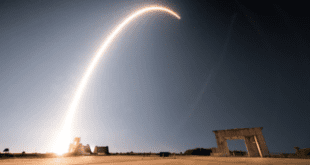
Japan’s Space One has declared that it will begin commercial launch operations in 2022, revealing an ambitious agenda for a company entering a very crowded regional and international market.
Space One plans to begin commercial launches of satellites in the fiscal year ending March 2022, as the growing field of private-sector space development focuses on smaller vehicles to cut costs. Just a few days before their announcement, Space One’s domestic rival suffered a fiery failure in a test launch, highlighting the lag of Japanese companies behind international peers in this field.
In an attempt to pool their resources and challenge the market, Canon Electronics, IHI Aerospace, Shimizu, and the Development Bank of Japan established New Generation Small Rocket Development Planning in August 2017.
The partners marked their updated mission this week by rebranding the group as Space One. Space One’s capitalization climbed to U.S.$12.6 million through private placements of new shares. The unit of Canon holds a 50% stake, while the ownership ratios of the other three partners have not been disclosed, according to Nikkei Asian Review.
In Japan, companies including Mitsubishi Heavy Industries have become involved in launching conventional heavy rockets as the creation of rockets for satellite launches continues to shift to the private sector. But the cost of one launch with a large rocket can exceed U.S.$100 million. A minirocket slashes the price significantly. Space One’s vehicle will measure roughly a dozen meters in length, which is approximately one-fifth the size of Japan’s mainstay rockets.
In the U.S., some companies launch satellites for $5 million. “We would like to set a price that cannot lose to the competition,” said Shinichiro Ota, president of Space One, in Nikkei Asian Review.
U.S. firm SpaceWorks Enterprises estimates that the demand for launching mini satellites will reach 460 in 2023, up 360% from the 2016 figure. This anticipated surge is driven by new applications for satellites, including farming, fisheries and container shipping.
While large rockets often need multiple satellites as payload to justify the cost of a launch, a minirocket launch can be profitable even for a single satellite. Space One aims to put 20 satellites into orbit annually by the mid-2020s, with each launch occurring within a year of the contract being signed.
However, this Japanese joint venture will be chasing its international rivals. The American company Rocket Lab put a satellite into orbit in January; China’s One Space Chongqing conducted a trial launch in May.
Japan has yet to put a privately built rocket into space. When Interstellar Technologies launched its MOMO rocket last summer, the flight was plagued by communications failure, and it landed in the ocean without leaving Earth’s atmosphere.Interstellar attempted another launch last Saturday,, but its rocket literally crashed and burned following the countdown. Interstellar Technologies plans to continue, possibly with the same launch pad since it appeared to sustain no damage.
Other companies, including Elon Musk’s SpaceX and Rocket Lab, have suffered early failures and postponements, but the race for commercial space development continues to grow.





